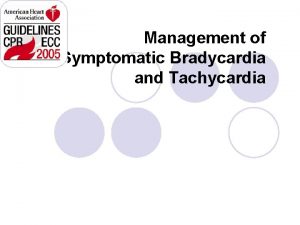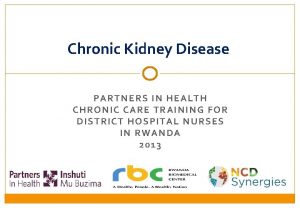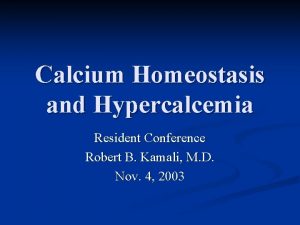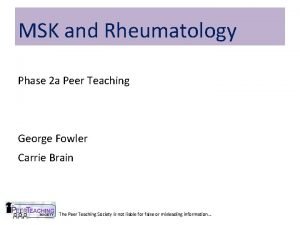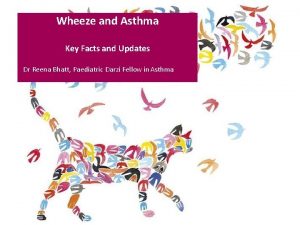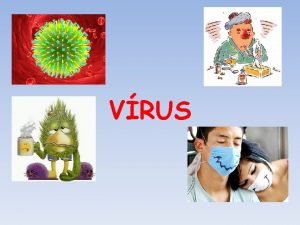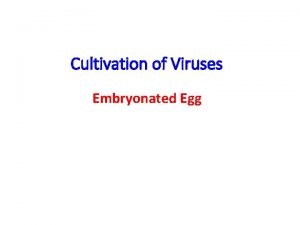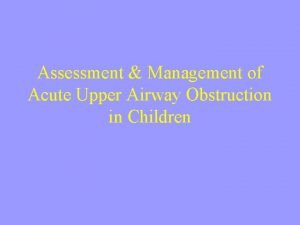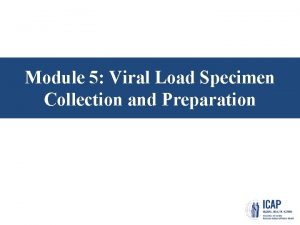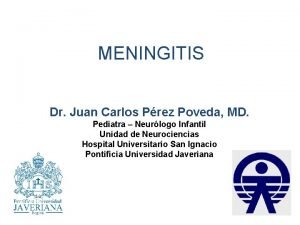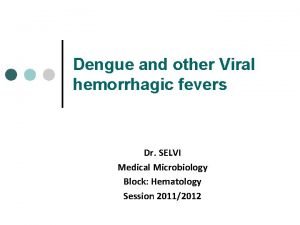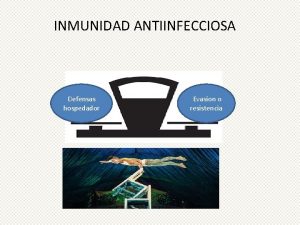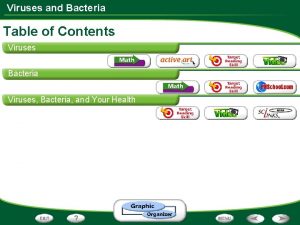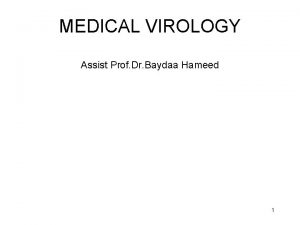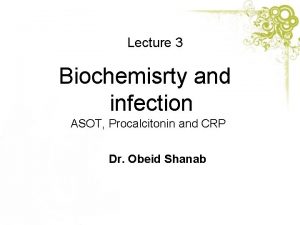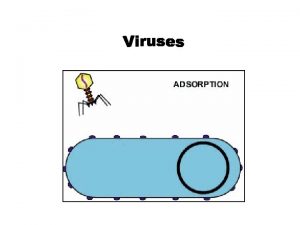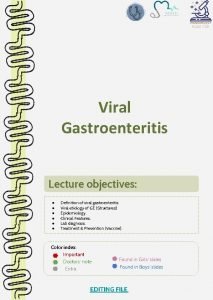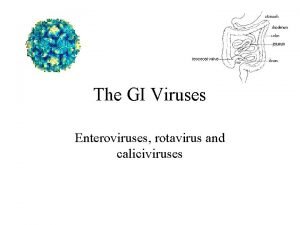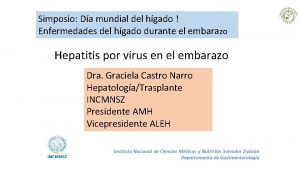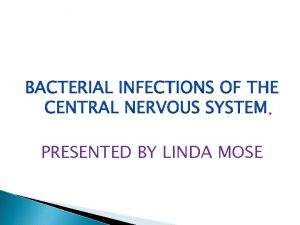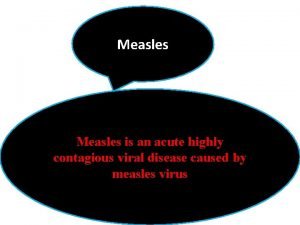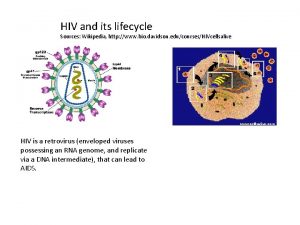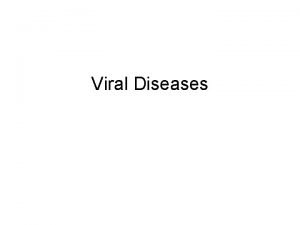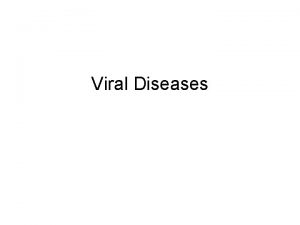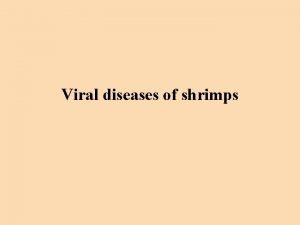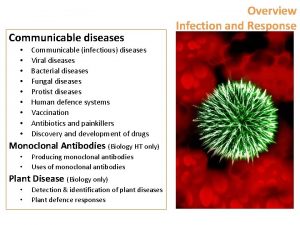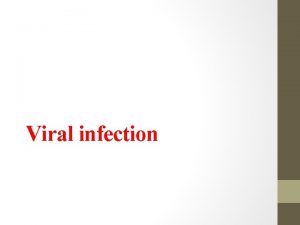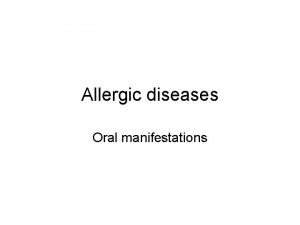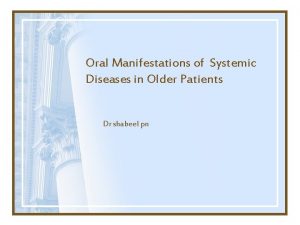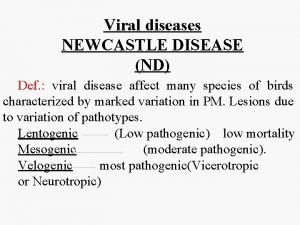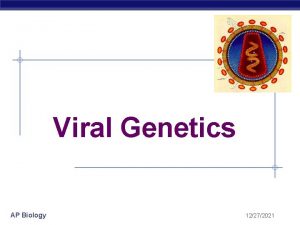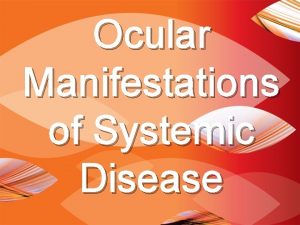Viral diseases and their symptomatic manifestations in oral













































- Slides: 45

Viral diseases and their symptomatic manifestations in oral cavity. AIDS, influenza, foot and mouth disease, mononucleosis. Etiology, clinics and diagnostics.

Viral diseases are extremely widespread infections caused by viruses, a type of microorganism There are many types of viruses that cause a wide variety of viral diseases: • • • Chickenpox Flu (influenza) Herpes Human immunodeficiency virus (HIV/AIDS) Human papillomavirus (HPV) Infectious mononucleosis Mumps, measles and rubella Shingles Viral gastroenteritis (stomach flu) Viral hepatitis Viral meningitis Viral pneumonia

Viral diseases are contagious and spread from person to person when a virus enters the body and begins to multiply Viral diseases can occur in any age group or population. Common ways that viruses spread from person to person include: 1. 2. 3. 4. 5. Breathing in air-borne droplets contaminated with a virus Eating food or drinking water contaminated with a virus Having sexual contact with a person who is infected with a sexually transmitted virus Indirect transmission from person to person by a virus host, such as a mosquito, tick, or field mouse Touching surfaces or body fluids contaminated with a virus

Oral mucous membranes may be infected by one of several different viruses Virus family: 1. Herpesviruses HSV 1 HSV 2 Varicella-zoster Epstein-Barr Cytomegalovirus HHV 6 HHV 8 2. Papillomaviruses 3. Coxackieviruses 4. Measles virus 5. Mumps virus Disease : Primary herpes gingivostomatitis Secondary herpes infections Genital herpes Varicella(chickenpox), zoster(shingles) Mononucleosis Hairy leukoplakia Burkitt’s lymphoma Salivary gland inclusion disease Roseola infantum Kaposi’s sarcoma Oral papillomas/warts, condyloma Herpangina, hand-foot-mouth disease Measles Mumps parotitis

What are the symptoms of viral diseases? Symptoms of viral diseases vary depending on the specific type of virus causing infection, the area of the body that is infected, the age and health history of the patient, and other factors. The symptoms of viral diseases can affect almost any area of the body or body system. Symptoms of viral diseases can include: • Flu-like symptoms (fatigue, fever, sore throat, headache, cough, aches and pains) • Gastrointestinal disturbances, such as diarrhea, nausea and vomiting • Irritability • Malaise (general ill feeling) • Rash • Sneezing • Stuffy nose, nasal congestion, runny nose, or postnasal drip • Swollen lymph nodes • Swollen tonsils • Unexplained weight loss

Herpes Simplex Infections • Herpes Simplex virus (HSV) infections are common vesicular eruptions of the skin and mucosa. They occur in two forms: -systemic; - primary. They may be: - localized ; - secondary in nature. Both form are self-limited, but recurrences of the secondary forms are common because the virus can be sequestered within ganglionic tissue in a latent state.

HSV

Primary Herpes Simplex Clinical features: • Most infections occur during childhood and subclinically; • Multiple painful oral ulcers preceded by vesicles; • May have similar perioral and skin lesions; • Systemic signs/symptoms (fever, malaise); • Self-limited; • Symptomatic care; • Immunocompromised have more severe disease. Treatment: • Acyclovir and analogs may control virus; • Must use early to be effective

HSV

Secondary herpes simplex Etiology: • Reactivation of latent virus, commonly precipitated by stress, sunlight, cold temperature, low resistance, and immunodeficiency. Clinical featured: • Affected usually adults and young adults, prodromal symptoms-tingling and • • burning; Affects perioral skin, lips, gingiva, palate-multiple small ulcers preceded by vesicles; Self- limited. Treatment: • • • Possible control with acyclovir and analogs; Must administer early; Systemic treatment

Primary herpetic infection

Varicella-Zoster • Primary disease (Varicella, Chickenpox): • Self-limited; • Common in children • Vesicular eruption of trunk and head, neck occuring in crops, few • • oral lesions Systemic signs/symptoms-fever, melaise… Symptomatic treatment • Secondary disease (zoster, shingles): • • • Self-limited; Adults; Rash, vesicles, ulcers unilateral along dermqatom, rare intraorally; Post herpetic pain can be severe immunompromised and lymphoma patients at risk; Treated with acyclovir and analogs


Varicella


Zoster

Complications of Herpes Zoster • Postherpetic Neuralgia • Herpes Zoster Ophthalmicus • VZV viremia • Dermatologic complications

Enteroviruses • Genus of the picornavirus family which replicate mainly in the gut • Single stranded RNA virus • Divided into 5 groups: - Polioviruses - Coxsackie A, B viruses - Enteroviruses - Herpanginia, hand-food-and-mouth disease, acute lymphonodular pharyngitis

Hand-foot-and-mouth disease Clinical features: • Painful ulcers preceded by vesicles on hands, • • • feet, and oral mucosa (buccal, labial mucosa and tongue most affected) After a short incubation period, vesicles with an erythematous halo appear in the oral cavity, on the hands, on the feet Affects usually children Treatment is symptomatic

Hand-foot-mouth disease

Herpangina Clinical features: • Endemic, seasonal occurrence; • Children most commonly affected; • Multiple painful ulcers in posterior oral cavity and • pharynx, lesions preceded by vesicles, diffuse erythematous pharyngitis is also present; Systemic symptoms (malaise, fever, dysphagia) • Treatment: • Self-limited (short, mild duration); • Not required

Herpangina

Measles (Rubeola) Etiology: • Measles virus(DNA virus) is spread by airbone droplets through the respiratory tract. Clinical Features: • Disease of children; • Seasonally appearing; • Prodromal symptoms: fever, malaise, conjunctivitis, photophobia, and cough develop; • Koplik’s spots precede maculopapular skin rash in the buccal mucosa. • There is no specific treatment (bed rest, adequate diet, fluids, analgesics)


Measles

Influenza • Influenza, commonly called "the flu, " is caused by viruses that infect • • the respiratory tract. Influenza viruses are divided into three types, designated A, B, and C, with A types usually causing the most problems in humans. Most people who get the conventional or seasonal flu recover completely in one to two weeks, but some people develop serious and potentially life-threatening medical complications, such as pneumonia. Much of the illness and death caused by conventional or seasonal influenza can be prevented by annual influenza vaccination. Influenza A undergoes frequent antigenic changes that require new vaccines to be developed and people to obtain a new vaccination every year. New vaccine technology is being developed.

Influenza

RNA viruses Illness caused by RNA viruses that infect the respiratory tract of many animals, birds, and humans. Symptoms: • Fever, cough, headache, malaise(tired, no energy), sore throat, nausea, vomiting, diarrhea. The majority of individuals has symptoms for about one to two weeks and then recovers with no problems. Treatment: • Symptomatics; • Prevention by vaccination

Human immundeficiency virus (HIV) • The human immunodeficiency virus (HIV) is a type of virus called a retrovirus, which infects humans when it comes in contact with tissues such as those that line the vagina, anal area, mouth, or eyes, or through a break in the skin (sexual transmission, blood or blood products, maternal-fetal transmission, infected needles). • HIV infection is generally a slowly progressive disease in which the virus is present throughout the body at all stages of the disease. Three stages of HIV infection have been described. • The initial stage of infection (primary infection), which occurs within weeks of acquiring the virus, and often is characterized by a flu- or mono-like illness that generally resolves within weeks. • The stage of chronic asymptomatic infection (meaning a long duration of infection without symptoms) lasts an average of eight to 10 years. • The stage of symptomatic infection, in which the body's immune (or defense) system has been suppressed and complications have developed, is called the acquired immunodeficiency syndrome (AIDS). The symptoms are caused by the complications of AIDS, which include one or more unusual infections or cancers, severe loss of weight, and intellectual deterioration (called dementia).

ACQUIRED IMMUNODEFICIENCY SYNDROME (AIDS) • HIV infection is associated with different lesions in the oral cavity – Candidiasis – Herpetic vesicles – Other oppurtunistic infections – Kaposi’s sarcoma: multifocal vascular tumor, present in 25% of AIDS patients; HSV 8 – Hairy leukoplakia: white patches with hairy surface: • caused by EBV • rare, but seen mainly in AIDS • histology shows acanthosis, hyperkeratosis

WHO Clinical Staging of HIV/AIDS for Adults and Adolescents Primary HIV Infection Asymptomatic Acute retroviral syndrome Clinical Stage 1 • Asymptomatic • Persistent generalized lymphadenopathy Clinical Stage 2 • Moderate unexplained weight loss (<10% of presumed or measured body weight) • Recurrent respiratory infections (sinusitis, tonsillitis, otitis media, and pharyngitis) • Herpes zoster • Angular cheilitis • Recurrent oral ulceration • Papular pruritic eruptions • Seborrheic dermatitis • Fungal nail infections Clinical Stage 3 • Unexplained severe weight loss (>10% of presumed or measured body weight) • Unexplained chronic diarrhea for >1 month • Unexplained persistent fever for >1 month (>37. 6ºC, intermittent or constant) • Persistent oral candidiasis (thrush) • Oral hairy leukoplakia • Pulmonary tuberculosis (current) • Severe presumed bacterial infections (e. g. , pneumonia, empyema, pyomyositis, bone or joint infection, meningitis, bacteremia) • Acute necrotizing ulcerative stomatitis, gingivitis, or periodontitis • Unexplained anemia (hemoglobin <8 g/d. L) • Neutropenia (neutrophils <500 cells/µL) • Chronic thrombocytopenia (platelets <50, 000 cells/µL) • •

WHO Clinical Staging of HIV/AIDS for Adults and Adolescents Clinical Stage 4 HIV wasting syndrome, as defined by the CDC (see Table 1, 1, above) Pneumocystis pneumonia Recurrent severe bacterial pneumonia Chronic herpes simplex infection (orolabial, genital, or anorectal site for >1 month or visceral herpes at any site) Esophageal candidiasis (or candidiasis of trachea, bronchi, or lungs) Extrapulmonary tuberculosis Kaposi sarcoma Cytomegalovirus infection (retinitis or infection of other organs) Central nervous system toxoplasmosis HIV encephalopathy Cryptococcosis, extrapulmonary (including meningitis) Disseminated nontuberculosis mycobacteria infection Progressive multifocal leukoencephalopathy Candida of the trachea, bronchi, or lungs Chronic cryptosporidiosis (with diarrhea) Chronic isosporiasis Disseminated mycosis (e. g. , histoplasmosis, coccidioidomycosis, penicilliosis) Recurrent nontyphoidal Salmonella bacteremia Lymphoma (cerebral or B-cell non-Hodgkin) Invasive cervical carcinoma Atypical disseminated leishmaniasis Symptomatic HIV-associated nephropathy Symptomatic HIV-associated cardiomyopathy Reactivation of American trypanosomiasis (meningoencephalitis or myocarditis) • • • • • •

Oral manifestation of HIV infection can be divided into three categories: • Group 1 lesions are strongly associated with HIV • • infection ( oral candidosis, linear gingival erythema, necrotizing gingivatis, necrotizing periodontitis); Group 2 lesions are less commonly associated with HIV infection (necrotizing stomatitis, melanotic hyperpigmentation, thrombocytopenic purpura, bacterial, viral infection); Group 3 lesions are seen in HIV infection ( oral infection with actinomyces israelii, escherichia coli, klebsiella pneumoniae)









Epstein-Barr virus infection or mononucleosis • member of the herpesvirus family of viruses (B • • • lymphotropic gamma-herpesvirus). causes infectious mononucleosis and oral hairy leukoplakia, and is associated with various types of lymphoid and epithelial malignancies (Burkitt's lymphoma, nasopharyngeal carcinoma) is very contagious and spreads from person to person through intimate contact with the saliva of a person who has the Epstein-Barr virus. causes infectious mononucleosis and oral hairy leukoplakia, and is associated with various types of lymphoid and epithelial malignancies

General symptoms of an Epstein. Barr virus infection • Symptoms of an Epstein-Barr virus infection are often mild, vague, • • • and similar to symptoms of a cold or the flu or there may be no symptoms of infection. Symptoms include: Body aches Cough Fatigue Headache Low-grade fever Malaise Runny or stuffy nose or nasal congestion Sneezing Sore throat Swollen tonsils

As mononucleosis progresses, symptoms become more severe and can include: - Extreme fatigue - Painful swollen glands (lymph nodes) in the neck, armpits or groin - Rash

Thank you for your attention
 Accelerated idioventricular rhythm
Accelerated idioventricular rhythm Contoh suffix terminologi medis
Contoh suffix terminologi medis Symptomatic polycystic kidney disease
Symptomatic polycystic kidney disease What is revolution
What is revolution Manifestations of hypercalcemia
Manifestations of hypercalcemia Extra articular manifestations of rheumatoid arthritis
Extra articular manifestations of rheumatoid arthritis Spirit of jealousy manifestations
Spirit of jealousy manifestations Wolff chaikoff effect
Wolff chaikoff effect Nail pitting
Nail pitting Chapitre 3 l'énergie et ses manifestations
Chapitre 3 l'énergie et ses manifestations Section 24-1 viral structure and replication
Section 24-1 viral structure and replication Aerochamber definition
Aerochamber definition Replicação viral ciclo lítico e lisogênico
Replicação viral ciclo lítico e lisogênico Pantropizm
Pantropizm Egg inoculation diagram
Egg inoculation diagram Viral inoculation in embryonated egg
Viral inoculation in embryonated egg Virus cultivation in embryonated eggs
Virus cultivation in embryonated eggs Spasmodic croup
Spasmodic croup Variola varicela
Variola varicela Exocitose
Exocitose Sample rejection criteria
Sample rejection criteria Meningitis
Meningitis Causes of viral hemorrhagic fever
Causes of viral hemorrhagic fever Ciclo viral
Ciclo viral Viral infection
Viral infection Viral
Viral Viral recombination
Viral recombination Vaccins à vecteur viral
Vaccins à vecteur viral Viral receptors
Viral receptors Viral
Viral Trivalent vaccin herpes
Trivalent vaccin herpes Viral dna
Viral dna Viral gastroenteritis
Viral gastroenteritis Viral entry
Viral entry The dynamics of viral marketing
The dynamics of viral marketing Hgado
Hgado Bacterial vs viral vs fungal meningitis csf
Bacterial vs viral vs fungal meningitis csf Viral arthritis
Viral arthritis An acute highly contagious viral disease
An acute highly contagious viral disease Viral life cycle
Viral life cycle Antiperytique
Antiperytique Viral shedding
Viral shedding Eline's viral
Eline's viral Andrew lippman mit
Andrew lippman mit Hiv life cycle wikipedia
Hiv life cycle wikipedia Vacinas subcutânea
Vacinas subcutânea
